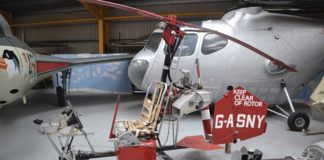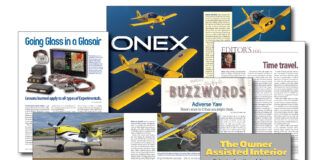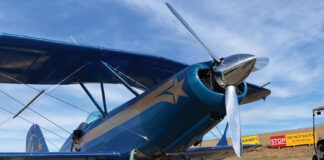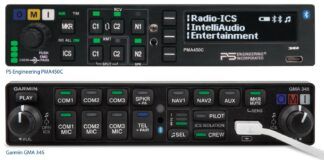Some of theabsolute best flying in my history has been in a floatplane, and chances are that’s true for some of you, too. After flying the Dream Aircraft Tundra several years ago [See Flight Review, KITPLANES March 2004], I was salivating at the prospect of going back to splash around on floats. Time passed, and in the fall of 2007, I planned to do just that. But Dream Aircraft’s Sales Manager Luc Premont said I’d better hurry, as the weather was getting colder, and it was time to put the Tundra back on wheels.
The timing couldn’t have been better. I lucked into a couple of days between rain showers where the air was clear and calm, temperatures were in the mid-50s, and we were blessed with unrestricted visibility. Adding to the ideal flying conditions was the spectacular fall foliage, providing a breathtaking background for my flight. But it was already late in the day when we arrived at the factory, so our float excursion would have to wait until morning. No matter, I was looking forward to touring the factory again to see what had changed since my last visit.
Some Kind of Workshop
Dream Aircraft founder Yvan Desmarais, who designed the Tundra after years of studying other bush planes, is also a senior partner in the firm of Desmarais and Gagne. D&G is a large manufacturing plant that specializes in the creation of big metal things. Walking across the shop floor, I noticed several new robotic welders busily at work, as well as the array of other impressive metalworking machines. The CNC punch press was tasked with a non-aviation project, giving me the chance to witness its flexibility when it was not punching out the many precise, fastener-size holes in the Tundra’s skins. Given the eclectic mix of large, complicated structures that were freshly manufactured and awaiting delivery, I could see how the production of Tundra components by D&G was a relative walk in the park.
Continuing up the stairs to what had been a small mezzanine, Premont and I entered a recently built shop area that now contained everything needed to produce Tundra quickbuild kits. Although several fuselages and wing sets were in various stages of construction, this newly expanded area had a spacious, well-ordered feel. All of the Tundra’s raw airframe components were neatly organized along one wall, and another wall sported one of each completed cable used in the Tundra. “These are used for reference,” Premont explained, “and the cables are already in place in the fast-build.” Airframe wiring harness templates had another spot on the wall. I came across a large box of Lycoming-style conical engine mounts, and asked Premont if they made these, too. “No, we’re still outsourcing those,” he said, somewhat apologetically. However, it didn’t take long for D&G to bring the construction of those motor mounts where they rightly belong, in house, as Premont updated me a few weeks after my visit.
Instead of the clattering din of rivet guns, the work that day was being accomplished with a barely audible rivet squeezer. An obviously practiced worker was busily creating bulkhead assemblies for a quickbuild kit, and actually seemed to be enjoying the work. Another employee was showing a colleague the finer points of wing construction, and both of them appeared to be having a good time with their tasks. It occurred to me that the unique satisfaction one gets from airplane building isn’t always confined to a garage or a hangar. Sometimes, if you’re lucky, it can even be found in your place of employment.
It Takes a Village
The “pond” in the village of Roxton Pond is more of a lake, surrounded by the residences of those who prefer living lakeside with their boats and floatplanes. Desmarais is one of the residents whose priorities are set straight. His grassy backyard slopes gently down to the water, where one of the factory Tundras is moored during float season. He even has avgas available close by, pumped from drums cleverly hidden from view with some creative fence work. Despite his affable, easygoing demeanor, I can see evidence that his brain is constantly at work, identifying problems and forming elegant solutions. Perhaps the best example of this is the Tundra itself.
Desmarais’ first prototype was 10 years in the making, debuting at Sun ‘n Fun in 2003. Other than a few well-placed refinements and the addition of a tricycle gear model, the basic Tundra is much the same now as it was then. Originally powered by a normally aspirated 180-horsepower Lycoming O-360, this second Tundra received a slight power increase with the substitution of a fuel-injected IO-360 rated for 20 more ponies, just the ticket for overcoming the aerodynamic drag from a set of straight floats and rigging.
Desmarais busied himself with the usual preflight drill of inspecting the airplane and floats, pumping out the bilges and topping off the fuel tanks. Admittedly, the PK 2300 straight floats are a bit undersized for the Tundra’s 2800-pound gross weight, and I was curious to see how this would affect the takeoff performance with three big guys aboard. Why a crew of three? With Desmarais limited to French, and me English, we needed the 200-pound Anglo/Franco translation unit aboard (otherwise known as Premont) to facilitate cockpit communications.
Saddle Up and Head Out
As conventional as the Tundra appears, no shortage of niceties make their value known as soon as you climb onto the float. The wide, gull-wing doors fold up against the wing, and make entering and exiting a breeze. The front seats have long fore-and-aft travel on the tracks, all the way back to the rear seat, so care must be taken if there is a set (or two) of knees in back. A structural gusset that impeded boarding in the first Tundra has been relocated, leaving plenty of room to swing my size 13s aboard as I assumed the shotgun position. With Premont in back and Desmarais in the left seat, the injected Lycoming was summoned into operation, and we slowly taxied out.
Although it was a bit chilly by California standards, I left my door open for a while to watch the right float slide gracefully through the glassy water. Given the flat, calm conditions, the effect was like taxiing on the world’s smoothest concrete. Eventually I took pity on our passenger and shut the door. Unlike many kit aircraft I’ve flown (including my own), the Tundra’s door easily swung down and shut solidly with an alignment more akin to a well-built automobile.
After the oil temperature finally came off the peg, and we were positioned for our takeoff run into what little wind there was, Desmarais dropped a notch of flaps, raised the water rudders, and brought the power in. As the floats quickly transitioned from plowing through the water to lifting onto the step, Desmarais held the stick in a relatively neutral position as the speed increased. In a moment or two, we had flying speed, but the smooth surface of the water was not about to give up its hold. A couple of short tugs on the stick were enough to break suction, and the sharp burst of acceleration in the seat of my pants told me we had just become a flying machine.
Air Manners
Climbing a couple of thousand feet, Desmarais turned the controls over to me, and I reacquainted myself with the Tundra. On conventional gear, the Tundra had initially impressed me with its solid, predictable handling. Now, flying with a set of floats and rigging underneath, its air manners were similar, and the Tundra seemed to shrug off the additional mass and drag. In cruise flight with 2500 rpm and 25 inches of manifold pressure, the airspeed indicator said we were just shy of 120 mph. With the air temperature gradually approaching 59 F as the sun climbed higher, our TAS hovered in the 110-knot neighborhood. Compared to my flight on conventional gear, the addition of floats and rigging seemed to have only a minor effect on cruise speeds. Then again, I reminded myself that this Tundra now sported a constant-speed prop and 20 more horses.
Stick forces seemed close to what I remembered from flying the taildragger, fairly light in pitch, heavier ailerons, and requiring just enough rudder going into turns to prevent your feet from getting indolent. As in my previous Tundra flight, a proper turn entry required a firm and simultaneous application of rudder with aileron. Back off on the rudder pressure in the turn, and the Tundra will go right back to reminding you that rudders have two purposes: One is to counteract adverse yaw, and the other is to make the pilot look like a novice if the rudders are ignored.
A noticeable improvement was the smoothness of the stock manual trim system, which surprised me with its precision. Making fine adjustments with the vertically mounted trim wheel was easy, and yet when larger corrections were required, moving the wheel to produce the desired amount of trim seemed almost instantaneous. Another upgrade was the refinement of the flap handle mechanism, which had been a bit clunky. Now it makes the selection of any of the four flap settings comparatively effortless and undemanding of your attention.
After making a few turns, we headed back for some water landings. I turned the controls over to Desmarais to see how it was done, Tundra style. Coming in low over the trees with two notches of flaps and an approach speed of about 80 mph, Desmarais set the Tundra down lightly in the water until the floats settled in, and then reapplied power to take off again before all forward momentum was lost. He turned the airplane over to me as we made a climbing left turn away from the lake, and it was my turn to splash down.
Dj Vu All Over Again
I must admit here that it had been a good long while since I’d made a landing in a floatplane. Relying on the Desmarais approach numbers as relayed through Premont, I set up a gradual descent downwind with a notch of flaps and 15 inches of manifold pressure. The second notch came in turning final, and I waited for the water to meet the floats. The glassy surface arrived a bit sooner than I was ready for, and Desmarais intervened with a slight tug on the stick during my roundout to make sure we met the water in the right attitude. We were rewarded with a nice landing, albeit quite a bit longer downrange than the ones Desmarais had achieved.
After taxiing back to the shore for my takeoff attempt, I lined up, set the flaps, and Desmarais pulled the water-rudder lanyard. After feeding in the power, it took me a few seconds of pitch experimentation to find the sweet spot on these floats, confirmed by Desmarais showing me exactly where the stick should be. As we planed along with increasing speed, I applied some left aileron and a touch of right rudder to keep us straight, and the right float obediently came out of the water and stayed there. Given the reduced drag, it didn’t take long for us to lift off the water and climb away.
My second landing was much better, now that I knew where the surface was and added some insurance by setting up a glassy water approach. Carrying a bit of power on final, nose high and descending at roughly 100 fpm, it was hard to determine exactly when the tails of the floats first contacted the surface.Ahhh!But I applied a bit too much up elevator upon pulling the power all the way off, and we bounced as the floats settled in.
The last approach and landing belonged to Desmarais, who showed me exactly how well a float-equipped Tundra can be slipped. I thought we were already low over the shoreline trees when he buried the stick toward the left cockpit sidewall, applied some right rudder, and the Tundra came down like a rock. As he released stick and rudder pressure, the Tundra immediately returned to its Clark Kent persona, touching down not far from shore. There’s no substitute for knowing your airplane, but the precise, “no surprises” control available from the Tundra certainly raises the pilot’s confidence level.
Back at the Ranch
After returning to D&G headquarters, we chatted about how the Tundra was doing in what has become a fiercely competitive kit aircraft market. The guys at Dream Aircraft know that the Tundra isn’t for everyone. As of this writing, about 35 kits have been delivered worldwide, with about half of those in North America. In every case, Tundra customers were looking for a well-constructed machine that could withstand the rigors of backcountry flying. Adding to their purchase decision was a conventional all-metal airframe that could be easily repaired, and an operational personality much like a faithful pooch. Although the Tundra won’t set speed records, it’s the kind of airplane the whole family will love for its off-road capability and solid construction.
Currently, the Montana Float Company is manufacturing what is considered to be the best choice for amphibious floats for the Tundra. These all-aluminum 2800 amphibs run close to $40,000, nearly the price of the basic Tundra kit, but they have features galore. Both male- and female-voiced recorded messages warn of wheels up or wheels down when power is reduced past a certain point, along with panel-mounted annunciator lights that make it tough to land in the wrong configuration. The floats come with all of the rigging and everything necessary to bolt them onto a Tundra.
The price of the basic kit has been hovering near $46,000 USD, subject to minor adjustments due to a fluctuating U.S./Canadian exchange rate. The quickbuild option adds $22,550 to the price, but will cut airframe build time dramatically. Add a new engine and prop, avionics and IFR instrumentation, and a set of new amphibious floats, and it wouldn’t be difficult to spend over $160,000. But others have opted for the standard kit, scrounged for used engines and avionics, and built nice airplanes for about half that amount.
There are approximately 23,000 solid rivets to set and buck. But you have the choice of doing it all yourself with Dream’s excellent color-coded construction guide, or letting the factory do the majority of the work before the airframe is delivered. Either way, you’ll end up with an airplane whose rugged design is well matched to your desire for backcountry adventure.
For more information, call Dream Aircraft at 866/500-9929 or 450/372-9929 or visit www.dreamaircraft.com.
Contact Montana Float at 406/293-9026, or visit www.montanafloat.com




